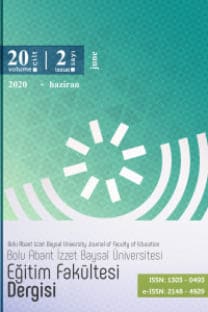OECD Verilerine Göre Pisa Sınav Sonuçlarının Değerlendirilmesi
Evaluating of Pisa Results Based on OECD Data
___
- Akarhielm, K. (1995). Doesclass size matter. Economics of EducationReview, 14(3), 229- 241.
- Çelikten, M., Şanal, M. ve Yeni, Y. (2005). Öğretmenlik mesleği ve özellikleri. Erciyes Üniversitesi Sosyal Bilimler Enstitüsü Dergisi,19(2), 207-237.
- Büyüköztürk, Ş., Çakmak, E.K., Akgün, Ö.E., Karadeniz, Ş. ve Demirel, F. (2015). Bilimsel araştırma yöntemleri. Ankara:Nobel Yay.
- Erdem, A. R. (2010). İlköğretim ve ortaöğretim öğretmenlerinin karşılaştığı ekonomik sorunlar ve bu ekonomik sorunların performanslarına etkisi konusundaki görüşleri. Uluslararası İnsan Bilimleri Dergisi, 7(1), 270-287.
- Figlio, D.N. (1997). Teacher salaries and teacher quality. Economic Letters, 55, 267-271.
- Gümüş, E. ve Şişman, M. (2012). Eğitim ekonomisi ve planlaması. Ankara: Pegem Akademi Yay.
- Hanushek, E.A. (1997). Assessing the effects of school resources on student performance: anupdate. Educational Evaluation and Policy Analysis, 19(2), 141-164.
- Hattie, J. (2006). The paradox of reducing class size and improving learning outcomes. International Journal of EducationalResearch, 43, 387-425.
- Hoxby, C. M. (2000). The effects of class size on student achievement: new evidence from population variation. Quarterly Journal of Economics,(2000a), 115(4), 1239-85.
- MEB (2015). PISA nedir? Alıntılanan web: http://pisa.meb.gov.tr/?page_id=18&lang=tr (alınma tarihi:30/04/15; 23:00).
- MEB (2013). Pisa 2012 ulusal ön raporu. Ankara: Yenilik Ve Eğitim Teknolojileri Genel Müdürlüğü.
- MEB (2010). Pisa 2006 projesi ulusal nihai rapor. Ankara: Eğitimi Araştırma ve Geliştirme Dairesi Başkanlığı.
- MEB (2005). Pisa 2003 projesi ulusal nihai rapor. Ankara: Eğitimi Araştırma ve Geliştirme Dairesi Başkanlığı.
- OECD. (2004). Education at a Glance 2004:OECD Indicators. OECD Publishing
- OECD. (2005). Education at a Glance 2005:OECD Indicators. OECD Publishing
- OECD. (2006). Education at a Glance 2006:OECD Indicators. OECD Publishing
- OECD. (2007). Education at a Glance 2007:OECD Indicators. OECD Publishing
- OECD. (2008). Education at a Glance 2008:OECD Indicators. OECD Publishing
- OECD. (2009). Education at a Glance 2009:OECD Indicators. OECD Publishing
- OECD. (2010). Education at a Glance 2010:OECD Indicators. OECD Publishing
- OECD. (2011). Education at a Glance 2011:OECD Indicators. OECD Publishing
- OECD. (2012). Education at a Glance 2012:OECD Indicators. OECD Publishing
- OECD. (2013a). PISA 2012 Results: Excellence Through Equity: Giving Every Student the Chance to Succeed (Volume II), PISA. OECD Publishing.
- OECD. (2013b). Education at a Glance 2013: OECD Indicators. OECD Publishing
- OECD (2014a). PISA in Focus. 2014/04 (April).
- OECD. (2014b). Strengthening Resilience through Education and Skills: PISA Results.
- OECD. (2014c). http://www.OECD.org/pisa/aboutpisa/ (alınma tarihi: 30/04/15; 23:00).
- Özdemir, S. (2013. Eğitim Yönetiminde Kuram ve Uygulama. Ankara: Pegem Akademi.
- Sağlam, M. ve Sağlam, A. Ç. (2005). Öğretmenlik mesleğinin maddi yönüne ilişkin genel bir değerlendirme. Türk Eğitim Bilimleri Dergisi, 3(3), 317-328.
- Sander, W. (1999). Endogenous expenditures and student achievement. Economics letters, 64(2), 223-231.
- Süngü, H. (2012). Bazı OECD Ülkelerindeki Öğretmen Maaşlarının Karşılaştırmalı Bir Analizi. 21. Yüzyılda Eğitim ve Toplum, 1(2), 21-45.
- Tunçkaşık, H. (2007). Türkiye'de ve çeşitli ülkelerde öğretmen maaşları. Ankara: TBMM Araştırma merkezi.
- ISSN: 1303-0493
- Yayın Aralığı: Yılda 4 Sayı
- Başlangıç: 2000
- Yayıncı: Abant İzzet Baysal Üniversitesi Eğitim Fakültesi
ÖĞRETMEN ADAYLARININ MATEMATİK ÖĞRETİMİNDE TEKNOLOJİK PEDAGoJİK ALAN BİLGİLERİNİN GELIŞTIRILMESF
Esra DEMİRAY, Nurbanu YILMAZ, Mutlu PİŞKİN TUNÇ, İlhan KARATAŞ
Asuman Seda SARACALOĞLU, Yasin AKAY, Murat ÇIRAKOĞLU
OECD VERİLERİNE GÖRE PISA SINAV SONUÇLARININ DEĞERLENDİRİLMESİ
İzzet Döş, Erkan Hasan Atalmış
OECD Verilerine Göre Pisa Sınav Sonuçlarının Değerlendirilmesi
İzzet Döş, Erkan Hasan Atalmış
İLKÖĞRETİM ÖĞRENCİLERİNİN OKUMA ALIŞKANLIĞINA İLİŞKİN VELİ GÖRÜŞLERİ
Duygu Saniye Öztürk, Ercan Aksoy
ORTAOKUL MATEMATİK ÖĞRETMENLERİNİN MATEMATİKSEL ALAN BİLGİLERİNİN İNCELENMESİ: PRİZMA ÖRNEĞİ
3-6 YAŞ ÇOCUKLARININ TERCİH ETTİKLERİ ÇİZGİ FİLMLERDEKİ ŞİDDET İÇERİKLERİNİN ANALİZİ
ÖĞRETMEN ADAYLARININ SANAT EĞİTİMİ İHTİYACINA YÖNELİK GÖRÜŞLERİNİN BELİRLENMESİ
